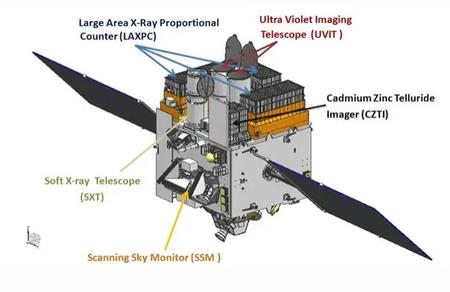
India's 1St Multi-Wavelength Astronomy Observatory Astrosat Completes A Decade
AstroSat, with a lift-off mass of 1515 kg, was launched on September 28, 2015, into a 650 km orbit by PSLV-C30 rocket from Satish Dhawan Space Centre in Andhra Pradesh's Sriharikota.
In the last 10 years, AstroSat has made remarkable discoveries, including the detection of far-ultraviolet (UV) photons from an astonishing distance of around 9 billion light-years, captured using the sharpest and widest-angle UV eye in space, the discovery of very fast-spinning black holes, and numerous other findings on X-ray emission from binary stars in the Milky Way.
“India's first observatory dedicated for astronomy. On this day 10 years ago, #AstroSat, India's first multi-wavelength astronomy observatory, was launched by ISRO,” the space organisation said in a post on social media platform X.
“From black holes to neutron stars, from the nearest star Proxima Centauri to the first time detection of FUV photons from galaxies 9.3 billion light years away, AstroSat enabled groundbreaking insights across the electromagnetic spectrum from UV/Visible to high energy X-rays,” ISRO added.
In a blog post, ISRO noted that AstroSat is capable of observing the universe simultaneously in a broad energy range from UV, visible, and high-energy X-rays, rendering it a powerful tool for understanding various cosmic phenomena.
It began the scientific journey by solving a 20-year-old puzzle involving a red giant star that was unusually bright in both UV light and infrared.
Its outstanding discoveries include the emission from the Butterfly Nebula, which extends three times more than the earlier known size, X-ray polarisation studies, a star reliving its youth, and the merging of galaxies.
ISRO noted that AstroSat has popularised space science, bringing astrophysics research into 132 Indian universities. About half of the observatory's users are Indian scientists and students, fostering a new generation of astronomers.
Notably, AstroSat also has a registered user base close to 3,400 from 57 countries worldwide.
The satellite, operated by the ISRO, collects data from its five scientific payloads to study various celestial phenomena, including black holes, quasars, and supernovae, contributing to a broader understanding of the universe.
Initially, designed for 5 years, AstroSat has far exceeded its design life.
“All five scientific experiments onboard AstroSat are working satisfactorily, and the observatory is expected to continue to provide many more new and exciting results in the coming years,” ISRO said.

Legal Disclaimer:
MENAFN provides the
information “as is” without warranty of any kind. We do not accept
any responsibility or liability for the accuracy, content, images,
videos, licenses, completeness, legality, or reliability of the information
contained in this article. If you have any complaints or copyright
issues related to this article, kindly contact the provider above.

















Comments
No comment